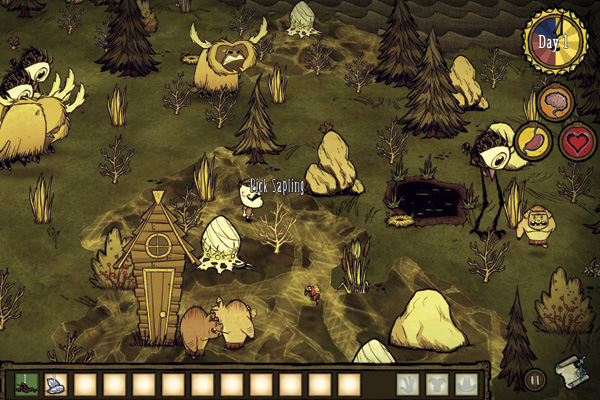Rating: 8/10
So far this year I have only reviewed games developed and distributed by the giants of the gaming industry. However, there is a whole other side to the industry. Thus far I have traversed the mainstream; this week we shall delve into the independent (or indie). The large capital necessary for game development has created a clear division between mainstream games, which cost outrageous amounts to make and are fairly limited in terms of how progressive they can be (but are overall generally spectacular), and the indie games. These independent games are generally made by a small group of designers on very tight budgets. The upside, however, is that because these developers arenít under the heel of some publishing giant, they are free to be as innovative as they please.One such game rife with innovation is Klei Entertainmentís game Donít Starve, which just officially launched on Steam (though it has been in open beta since last year) This game seeks to add something new to the current resurgence of open-world survival games. Unlike other current games in this genre like Day Z or Slender, Donít Starve isnít seeking to scare the living beejezus out of you, but rather seeking to emphasise the idea of survival.
When you first start the game you enter the world as the default character ďThe Gentleman Scientist,Ē who is described as being capable of growing a magnificent beard. The first thing that strikes me is the art style of the world. Indie games frequently employ unconventional art styles and Donít Starve is no exception,. Its style is faintly reminiscent of scary German fairy tales. The camera gives you a birdís eye view of your character and the world.
The aim of the game is simple: donít die. There are three ways you can die Ė through starvation, insanity or trauma. You are free to explore the world at your own pace, but your exploration will always be underpinned by this one objective of survival. Starvation can be avoided by eating (obviously) so you are always on the hunt for food sources, and as you progress you can produce farms and crops to make staying fed easier. Insanity is avoided by keeping your mind active by constructing things. All objects in the world are interactive and provide resources that can be manipulated or combined to create useful objects. For instance, you begin with absolutely nothing, but pick up a flint and a twig and voilŗ, you have a torch.
There is a plethora of objects to construct, which all benefit survival in some way. The game has a cycle of days which are broken down into daytime, evening and night. It is possible to explore and construct during daytime; however, night brings pitch blackness full of monsters that will kill you unless you are beside a roaring fire.
The number of days you manage to survive determines the amount of experience you get upon your death. This experience levels you up, unlocking new characters to play as. Each character has its own set of skills, which make different areas of survival easier.
Every time you die the world resets, providing you with a brand new map. However, this also means that you have to start again from scratch, which can be annoying. But youíll find that on every playthrough you get more and more adept at surviving, at knowing which supplies you need and which constructions to build.
Klei Entertainmentís Donít Starve is a great example of the strengths of the indie market. It provides innovative gameplay that is challenging and interesting as well as having a unique visual style and just being bloody fun. Plus itíll cost you a sixth of a AAA title.




